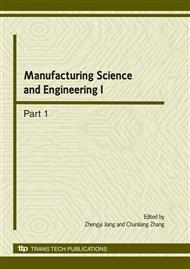[1]
H. Hayashi and T. Nakagawa, Recent trends in sheet metals and their formability in manufacturing automotive panels, Journal of Materials Processing Technology, Volume 46 (1994), 455-487.
DOI: 10.1016/0924-0136(94)90128-7
Google Scholar
[2]
M. Kleiner, S. Chatti, and A. Klaus, Metal forming techniques for light weight construction, Journal of Materials Processing Technology, Volume 177 (2006), 2-7.
DOI: 10.1016/j.jmatprotec.2006.04.085
Google Scholar
[3]
V. Ivanov, Profiling of Rollers for Thread Rolling, Journal of Materials Processing Technology, Volume 59 (1996), 333-336.
DOI: 10.1016/0924-0136(95)02159-0
Google Scholar
[4]
A. Gontarz, Z, Pater, and W. Weronski, Head forging aspects of new forming process of screw spike, Journal of Materials Processing Technology, Volume 153-154 (2004), 736-740.
DOI: 10.1016/j.jmatprotec.2004.04.164
Google Scholar
[5]
M. Salmani Tehrani, H. Moslemi Naeini, P. Hartley, and H. Khademizadeh, Localized edge backling in cold roll-forming of circular tube section. Journal of Materials Processing Technology, Volume 177 (2006), 617-620.
DOI: 10.1016/j.jmatprotec.2006.03.201
Google Scholar
[6]
G. Nefussi, L. Proslier, and P. Gilormini, Simulation of the cold-roll forming of circular tubes, Journal of Materials Processing Technology, Volume 95 (1999), 216-221.
DOI: 10.1016/s0924-0136(99)00323-4
Google Scholar
[7]
S. Kalpakjian, Manufacturing Processes for Engineering Materials, Addison-Wesley Publishing Company 3rd Edition (1997), 122-125.
Google Scholar
[8]
T. Mori, and S. Kurimoto, Press formability of stainless steel and aluminum clad sheet, Journal of Materials Processing Technology, Volume 56 (1996), 242-253.
DOI: 10.1016/0924-0136(95)01838-7
Google Scholar
[9]
M. Zhan, H. Yang, J. H. Zhang, Y. L. Xu, and F. Ma, 3D REM analysis of influence of roller feed rate on forming force quality of cone spinning, Journal of Materials Processing Technology, Volume 187-188 (2007), 486-491.
DOI: 10.1016/j.jmatprotec.2006.11.114
Google Scholar
[10]
H. Yan, H. Bi, and Z. Xu, Microstructure texture and grain boundaries character distribution evolution of ferritic stainless steel during rolling process, Journal of Materials Processing Technology, Volume 209 (2009), 2627-2631.
DOI: 10.1016/j.jmatprotec.2008.06.012
Google Scholar
[11]
Y. Abe, K. Mori, and O. Ebihara, Optimization of the distribution of wall thickness in the multistage sheet metal forming of wheel disks, Journal of Materials Processing Technology, Volume 125-126 (2002), 792-797.
DOI: 10.1016/s0924-0136(02)00394-1
Google Scholar


